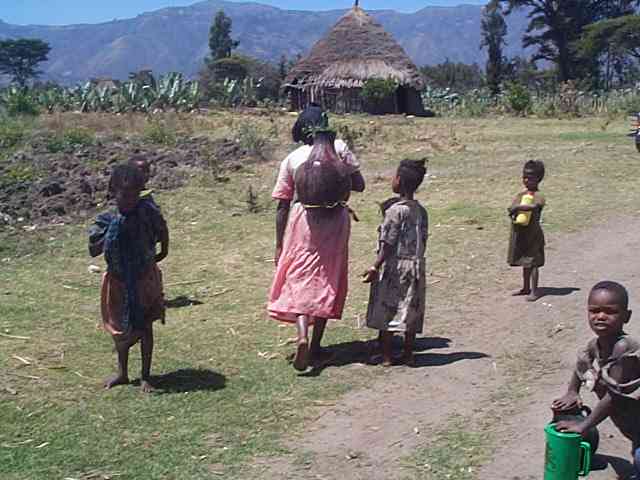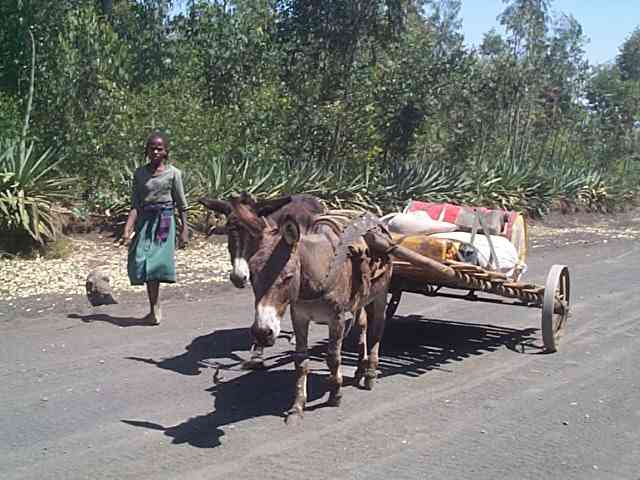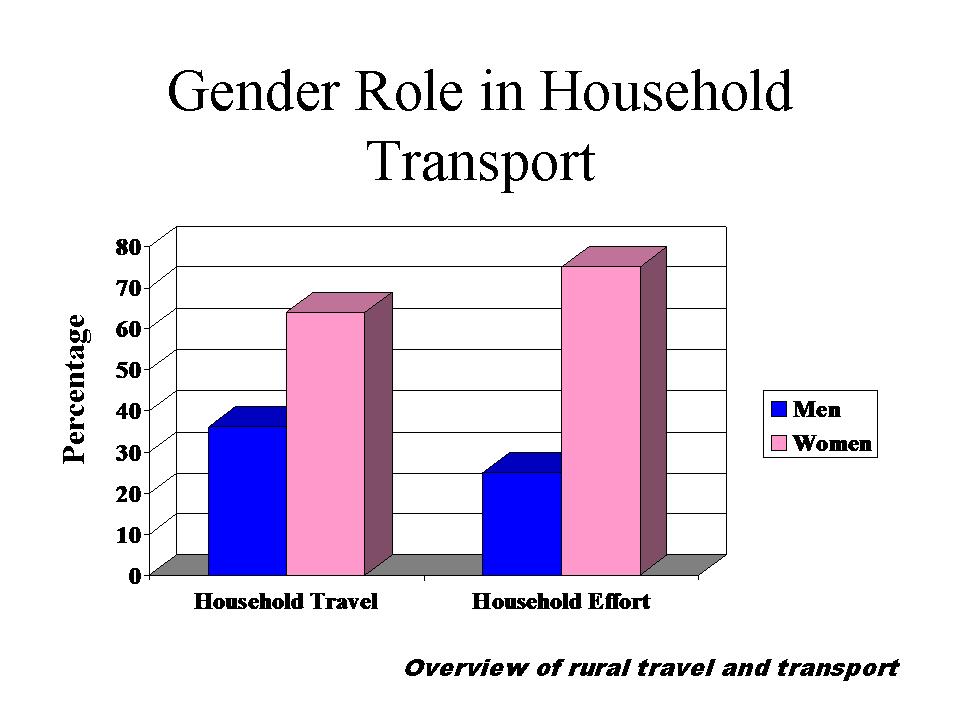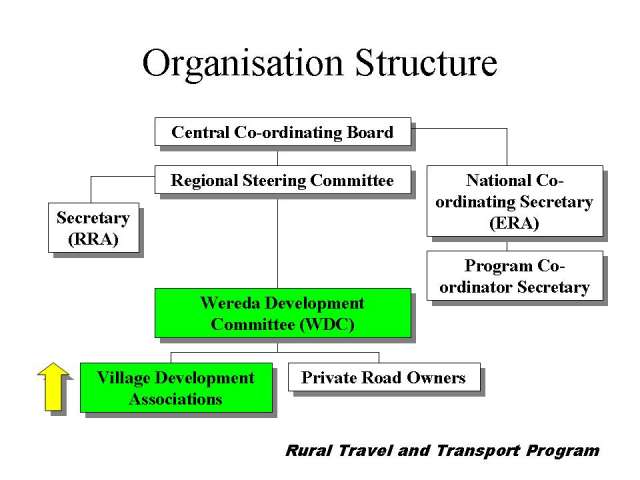|
RTTP Front Page
Acknowledgements
Ethiopian Rural Travel and Transport Programme
|
Abbreviation |
Full Description |
|
4WD |
Four Wheel Drive Vehicle |
|
ERTTP |
Ethiopian Rural Travel and Transport Programme |
|
IMTs |
Intermediate Means of Transports |
|
NGO |
Non-government Organisation |
|
RRA |
(Regional) Rural Roads Authority |
|
RSDP |
Road Sector Development Programme |
|
RTTP |
Rural Travel and Transport Programme |
|
SSA |
Sub-Saharan Africa |
|
SSATP |
Sub-Saharan African Transport Policy Programme |
|
VDA |
Village Development Association |
|
WDC |
Wereda Development Committee |
|
WTTP |
Wereda Travel and Transport Plan |
Introduction
There are clear links that show improved rural access in developing countries creates better living standards, reduces poverty and stimulates the local economy. To reduce rural poverty, therefore, better mobility is required, which in turn, requires better transport infrastructure, and improved and affordable transport services. Isolation relates to poverty. People live in an extremely small world if the only form of transport is by foot.
Recent studies show that the predominant form of transport in rural villages consists of head, back and shoulder loading which is mainly undertaken by women. There is a growing awareness that past efforts to improve rural transport, by building roads, have failed to reduce the transport burden of the rural population. Projects, which focus on roads and motor vehicles, repeatedly fail to address the transport needs of rural communities.
Rural transport is not confined to the road sector; many different sectors are involved. It is therefore essential that a multi-sectoral approach be taken during the planning phase. Even if good quality roads are available, few rural households have access to motor vehicles and therefore must rely on either transport services, which are very expensive, or other forms of basic transport.
What is the Rural Travel and Transport Programme?
The Rural Travel and Transport Programme (RTTP) is part of the Sub-Saharan Africa Transport Policy Programme (SSATP), which consists of a joint agreement between several bilateral and multi-lateral organisations. SSATP provides assistance to developing country governments in the formulation and implementation of improved transport strategies. There are approximately ? countries, including Ethiopia, participating in the RTTP.
The overall goal of RTTP programme is to improve the livelihoods of rural people by improving access to markets, grinding mills, health centres, schools, and administrative and financial services. It also aims to provide better access to basic amenities such as water and firewood.
The specific objective of the RTTP is to help develop national rural transport policies and strategies within developing countries. This can be summarised as follows:
· Improve the planning, financing and maintenance of rural roads, tracks, paths and footbridges;
· Provide motorised and non-motorised rural transport services to move people and goods;
· Promote the use of least-cost methods, local resources, and small contractors for rural transport infrastructure works.
Women and Rural Transport
Studies have shown that it is the women that bear the greatest transport burden in rural areas. Initial studies conducted by I.T. Transport Ltd. For ERA Village Level Travel & Transport Study 1999 provide an insight into the actual situation as shown in Figure 1.
The majority of domestic transport, and most agricultural transport, is undertaken by either women or by donkeys. Decisions to purchase IMTs are generally made by men. However, men have a general disregard of women’s time, probably because there are no alternative productive opportunities for women. The situation is unlikely to change without outside pressure.
Plate 1 - Traditional Means of Water Collection

Plate 2 – An Appropriate Means of Reducing the Transport Burden

The pilot studies, being undertaken in the ERTTP, must therefore investigate the situation of women. How do they collect water? How many hours do they spend going to the grinding mill? It is therefore intended to involve women at all stages of the design and implementation process.
Figure 1 - Gender Role in Rural Household Transport

Background of ERTTP
Ethiopia has embarked on a major Road Sector Development Programme (RSDP) (Phase 1 1996/2002 and Phase II 2002/2007) which involves, among other things, the rehabilitation of its entire strategic road network. This will provide a massive stimulus to the national economy. However, this alone will not solve the problem of rural access. It is estimated that 80% of the Ethiopian population live more than a half-day’s walk away from an all-weather road.
The Ethiopian government recognised that the basic ideas and concepts proposed within RTTP were ideal for the implementation and sustainability of rural access and it was therefore included within the RSDP. However, it was necessary to adapt the RTTP concept in such a way that it would work within the Ethiopian arena. Of particular concern was the need for sustainability.
In-depth discussions were undertaken with all stakeholders, policies, strategies and legal framework were developed, and suitable organisational structures were established at all levels of government. Without these appropriate measures being taken, the programme would have had little chance of success.
ERTTP Institutional Arrangements
The success and sustainability of the programme is dependant on the institutional and legal framework set-up for the ERTTP. Several national workshops and studies were undertaken in the process of preparing suitable policies, strategies and a suitable institutional framework. It was decided that the Wereda (smallest Ethiopian administrative unit), should take the decisions within ERTTP (the proposed organisational structure is shown in Figure 1), and that this must operate within the macro (national and regional) context. It was therefore necessary to change the Law to make it possible for “a community” to own a road providing the basics for a network of community owned and sustained roads. The legal ownership of roads by communities is considered to be fundamental to the successful implementation and sustainability of the ERTTP.
The Ethiopian Government is now establishing the organisational structure shown in Figure 1. The status of this establishment as of November 2001 is as follows:
· A Central Programme Co-ordinating Board was established in April 2001. Due to political reasons, this board is very large and is unlikely to meet at intervals less than one year. However, its existence places emphasis and shows government commitment to the programme.
· The Regional Programme Co-ordinating Committee is in the process of being set up. The Regional Rural Road Authorities (RRAs) play an important role in the co-ordination of ERTTP and appropriate measures have been included in their legal proclamations and organisational structures to cater for this.
· Wereda Development Committees and Village Development Associations already exist is some form or other. These organisations will be the decision makers and the implementers of the programme.
Figure 2 Organisational Structure of ERTTP

The ERTTP guiding principles are as follows:
· The local communities will decide the nature and priority of the interventions to improve rural travel and transport;
· The local communities will provide (unskilled) labour, locally available materials and/or cash contributions to any proposed interventions;
· The government, donors and private investors will strengthen the development efforts under the communities by providing, wherever possible, inputs such as technical advice and supervision and the provision of materials not available locally and other resources that are beyond the means of the communities to provide.
· The Government will provide the necessary co-ordination and training for the programme and will help to transfer knowledge and ideas between different areas of the country. This will be arranged primarily through existing Government structures and in co-operation with the ERTTP.
The main duties and responsibilities of the WDC and VDA are as follows:
· Raising awareness among the local communities on the aims and objectives of the ERTTP;
· Liaise with NGOs and potential Donors;
· Facilitate the undertake appropriate studies etc.;
· Identify and prioritise projects;
· Prepare a Wereda Travel and Transport Plan (WTTP);
· Organise the mobilisation of resources from local communities in terms of labour, local materials and financial contributions.
ERTTP Start-up Activities
ERTTP is programmed for implementation over the next 7-year period. Ireland Aid is funding the initial activities, however, it is expected that many donors and NGOs will be involved in the future.
The start-up activities funded by Ireland Aid include:
· The study of eight pilot Weredas;
· Preparation of procedural manuals;
· Training of trainers for Wereda Technicians (technical advisors at Wereda level);
· Awareness raising workshops at Regional level.
Expected Outputs from the Pilot Wereda Studies
The methodology for the pilot Wereda studies is intended to ensure that community's needs and priorities are taken into consideration. For this reason a bottom up approach (i.e. full community participation) will be used in the process of identifying potential interventions. Proposed interventions must be affordable, acceptable and sustainable.
The main output from the methodology will be a “Wereda Travel and Transport Plan”(WTTP). The details contained within this plan will depend on the individual circumstances found within each Wereda and how the communities perceive the problems following consultation with the study team members.
Solutions to travel and transport problems may consist of any or all of the following:
· data showing which tasks contribute to the transport burden and the division of labour between men and women;
· maps detailing the locations of all community services and facilities and path and road network ;
· specific transport interventions, such as improvement or construction of bridges, paths and roads, introduction or promotion of appropriate transport services;
· non-transport interventions in different sectors that would generally improve access of rural people to goods and services;
· trained local staff able to identify access problems and formulate action plans.
Transport Infrastructure
Appropriate standards have been prepared by the ERA. Road standards now include a range of standards which cater for IMTs and 4WD vehicles and are tailor made to be built by labour-based technology.
Roads can be constructed to accommodate appropriate transport such as a single truck, a 4WD, IMT. They may even be constructed just for walking if this is considered by the community to be the requirement.
Not all the surface need be gravelled. Past attempts by road agencies to construct dry-weather roads have frequently failed due to uncontrolled trafficking during the wet season. Community owned roads differ in that the communities control access and therefore earth roads or partly gravelled roads become a viable option.
Intermediate Means of Transport
Intermediate Means of Transport are those means of transport, which are intermediate between the traditional mode of walking with loads carried on the head, back or shoulder, and modern conventional motor vehicles such as cars pick-up, trucks or buses. A wide range of non-motorised and motorised IMTs are used in SSA including: wheel barrows, handcarts, pack donkeys, Ox drawn sledges, animal drawn carts, bicycle (sometimes with a trailer), and motor tricycle.
There are already some IMTs in Ethiopia but they are not widely used throughout the country. It is intended, as part of the ERTTP to promote IMTs. Some of the problems to be overcome in their promotion of more widespread use are as follows:
- Topography - Ethiopia is a mountainous country creating a major constraint to the type of IMT, which can be successfully employed.
- Cultural factors - can have a profound effect on the acceptability of different IMTs especially for women.
- Demography - the distribution of the rural population affects the distances to be negotiated to gain access to markets etc.
- Economic factors - this is probably the biggest constraint as the annual income of a peasant farmer is less than $100. Where suitable IMTs are likely to be expensive for individual households, it may be possible for shared ownership by groups of households.
If IMTs already exist within an area, it is likely that existing designs will be improved as much as possible to improve efficiency and reduce costs. Familiarity will ease the promotion.
The most promising type of intervention is likely to be one that adapts or reduces the manufacturing cost of IMTs already in use and familiar. In designing training assistance it will be necessary to undertake analytical profiles of the staff skills in existing enterprises, review existing training facilities, establish the ability and willingness of manufacturers to pay for training and consider how training can be delivered most cost-effectively. Where new production technologies or components are required, checks should be made on the likely sustainability of supply. On the financial front, the main issue will be to ensure that an intervention will not lead to unacceptable distortions. Business development may cover financial and staff management, production planning, market research, and promotional work.
Non-transport Solutions
It is expected that many of the solutions proposed for reducing the transport burden will involve a non-transport solution.
Examples of non-transport interventions include:
- Rural water projects - they must provide reliable, all year supply of potable water close to the home. Large reductions in transport burden can be realized with this type of intervention.
- Siting of facilities - the provision of social and economic facilities (particularly grinding mills) closer to the home can significantly reduce travel time.
- Wood burning stoves - the introduction of improved wood burning stoves can significantly reduce firewood consumption with a corresponding reduction in transport burden.
- Woodlots - Planting woodlots closer to the home can reduce the time and effort spent on fire wood collection. This is a long-term intervention because woodlots take several years to mature.
Conclusions
ERTTP is seen as a tool to advance reform in rural roads and transport policies, stimulate rural development and reduce poverty. The programme promotes five key approaches
· It has established policies and strategies for rural roads and transport.
· It has provided the institutional framework between government and local communities to build and maintain village access roads.
· It has developed a legal and financial framework that encourages local communities to claim ownership of their roads.
· It has decentralised decision making to the village level (i.e. it involves and empowers those who suffer the consequences of poor maintenance and lack of access).
· It considers solutions to travel and transport other than just roads. Significant improvements in mobility are best achieved by bettering both infrastructure and transport services, including acquiring low-cost vehicles. Access can also be improved if facilities are better placed.
· It promotes the use of appropriate technology and the use of local labour and materials.
November 2001
© Copyright 2010 Brian Barr Consulting Services Ltd.
|